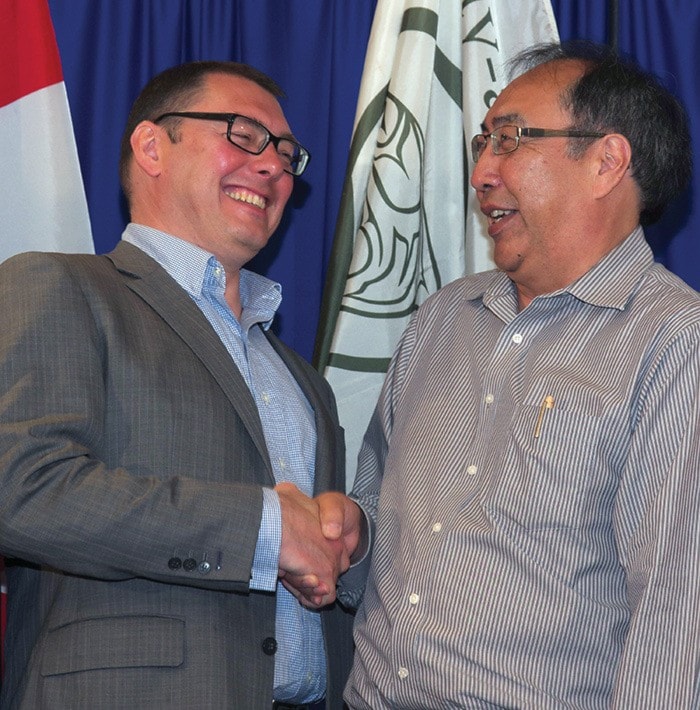The Huu-ay-aht First Nation’s dream of an LNG facility has taken a giant step closer to reality.
The Huu-ay-aht and liquid gas conglomerate Steelhead LNG signed an agreement on Tuesday that will see them explore the possibility of building a $30 billion liquid natural gas (LNG) plant in Sarita Bay.
“In 2011 we signed the Maa-nulth Treaty and it changed our lives,” said Jeff Cook, chief councillor of the 750-member Huu-ay-aht. “We said afterward that we are open for business and we’ve been pursuing that.”
The proposed plant would be built on Huu-ay-aht land at Sarita Bay, approximately 10 kilometres north of their village in Anacla.
Steelhead filed for an export licence from the National Energy Board to export up to 30 million tonnes of LNG annually for 25 years. “That could be used for this site,” Steelhead CEO Nigel Kuzemko said. The company hopes to launch with 12 million tonnes of annual LNG capacity by 2022.
The operation could possibly expand and involve other partners, Kuzemko said.
The Port Alberni Port Authority linked the company with the Huu-ay-aht after signing a protocol agreement with the tribe last winter.

The company consulted with the tribe long before the Supreme Court handed down the pivotal Tsilhqot’in decision last month, which requires development projects such as pipelines to seek aboriginal approval.
“We want to be in the front door,” Cook said. “We’ve always been left behind in the consultation process. “Steelhead came to us long before the court decision.”
Steelhead officials examined several sites along the B.C. coast but considered Anacla most advantageous. “It’s flat and requires little blasting. There’s deep water. And there is easy access,” Kuzemko said.
The agreement with Huu-ay-aht is to explore developing the facility. How much money the company is investing in the exploration is private, he added.
Major buyers of LNG have been Canada and the United States. But according to a BC Government press release, emerging economies in China, India and elsewhere in Asia have increased demand for natural gas, creating an opportunity for B.C. to get into the LNG game.
But B.C. is competing with Russia, Canada (on a federal level) and Australia who are vying for market position with their own LNG projects.
Steelhead doesn’t have a buyer yet but has fielded cursory inquiries from Asian buyers. “Until you have product a buyer won’t have substantive talks with you,” he said. “But we have an excellent site and a partnership with a First Nation so we’re in a better position to have more substantive talks.”
According to a B.C. government website, there are 14 LNG export projects in the queue. Campbell River is the only other project on the Island. The government hopes to have three LNG facilities in operation by 2020.
Exploring environmental and cultural impacts will be part of the due diligence exercised as part of the exploration. The environmental approval alone could take four years, Kuzemko said.

The project will have its challenges, he added.
Financing has to be secured for the project. A new pipeline would have to be built to transport natural gas to Vancouver Island across Georgia Strait.
Part of the exploratory talks will look at how the Huu-ay-aht can help broker agreements with First Nations located along the pipeline route.
The Sarita site is also a considerable distance from upstream gas production and overcoming that will be part of the exploratory talks, Kuzemko said.
Another challenge is First Nations consultations. The project is in Huu-ay-aht territory but the tribe shares boundaries with the Ucluelet, Toquaht and Tseshaht. Salmon that the Tseshaht and Hupacasath First Nations depend on migrate through Huu-ay-aht territory.
Cursory talks have been held with all but one tribe. “Hupacasath hasn’t responded to our calls,” Cook said.
Further talks with First Nations are planned as the project progresses.
reporter@albernivalleynews.com
Twitter.com/AlberniNews
